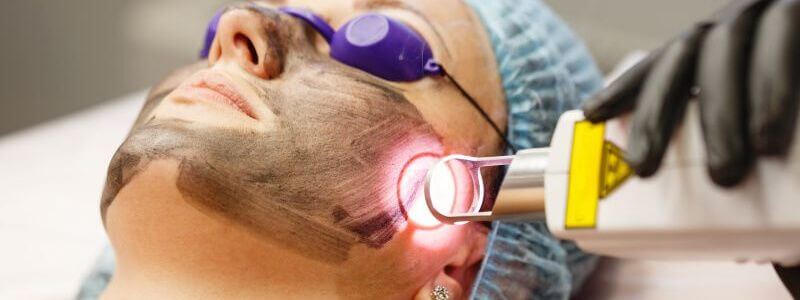Both the laser carbon peel and the chemical skin peel are popular in skincare. They are effective for acne and have anti-aging benefits. While they address similar issues, they are distinct treatments. Let’s examine them individually and compare their differences.
Carbon Laser Peels
Carbon laser peel, also known as the ‘Hollywood peel,’ is a popular treatment for oily skin, acne, wrinkles, and fine lines. It can be performed on specific areas or the entire face. The procedure removes damaged outer skin, resulting in smoother and softer skin. It also stimulates collagen and elastin production for a youthful appearance.
During the treatment, a layer of liquid carbon is applied to the skin. As it seeps into the pores, laser beams destroy it, removing dead skin cells and other impurities.
Ideal Candidate for Carbon Laser Peel
Ideal Candidate for Carbon Laser Peel You are an ideal candidate for the carbon laser peel if you:
- Have wrinkles and fine lines due to aging
- Suffer from acne or oily skin
- Are affected by environmental factors like sun damage
- Have an uneven skin tone
- Have hyperpigmentation
- Are concerned about facial scars
- Have other skin imperfections
Benefits of Carbon Laser Peel
Boosts Collagen Production
Promotes collagen production, making the skin firmer and accelerating cell regeneration.
Skin Rejuvenation
Removes dead skin cells and debris, resulting in immediate rejuvenation and a radiant, youthful appearance.
Cleanses Pores
Effectively cleans clogged pores, reduces oil production, and prevents acne by shrinking sebaceous glands and killing bacteria.
Quick Procedure
Takes only five to ten minutes with no discomfort or pain.
No Downtime
Pain-free procedure with no recovery time, allowing immediate return to daily activities.
Exfoliating
Removes dead skin cells and blackheads, leaving the skin radiant, softer, and even-toned. Can also reduce pore size.
Chemical Peels
A chemical peel is a skincare treatment that improves the skin of the face, neck, and hands using a chemical solution. It exfoliates the upper skin layer, removing dead cells, and results in smoother, firmer, and younger-looking skin. Chemical peels are used to treat acne scars, aging skin, age spots, crow’s feet, melasma, shallow scars, hyperpigmentation, sagging skin, wrinkles, and sun damage. There are three types of chemical peels:
- Superficial or lunchtime peel
- Medium peel
- Deep peel
The choice of chemical peel depends on the clinician’s skin analysis.
Superficial or Lunchtime Peel
This type uses alpha-hydroxy acid or a mild acid to gently exfoliate the outer skin layer. It refreshes the face, neck, chest, and hands, improves rough skin, and treats discoloration.
Medium Peel
This type uses trichloroacetic or glycolic acid to penetrate the outer and middle skin layers, removing damaged cells. It improves fine lines, wrinkles, age spots, freckles, discoloration, and rough skin. It can also treat precancerous growths like actinic keratosis.
Deep Peel
This type uses phenol or trichloroacetic acid to deeply penetrate the middle skin layer, eliminating damaged cells. It treats freckles, age spots, and shallow scars. However, it can only be performed on the face and only once.
Ideal Candidate for Chemical Peels
Chemical peels are sensitive to the skin and are ideal for fair-skinned and light-haired individuals. You are not an ideal candidate if you:
- Have any active skin disease or infection
- Have sunburns or broken skin
- Have herpes simplex 1 sores
- Are pregnant or nursing
- Have taken Accutane in the last six months
- Have used skin lightening or bleaching products in the last 48 hours
The Downtime
Superficial peels take about one to seven days to heal, and cream is usually applied to the treated area since it might scale and get red. Applying sunscreen is a must daily.
Medium peels take one to two weeks to heal, and the skin is usually swollen and red for the first 38 hours, and the eyelids may swell and shut. There may also be blisters and crusts form and peel off. The skin must be soaked for a certain period, followed by ointment application and antiviral medication. A follow-up appointment is a must and completely avoiding the sun is necessary until you are fully healed.
Deep peels take about two to three weeks to heal, and the treated area is usually bandaged. The treated area is soaked 4-6 times a day, followed by an ointment application. Moisturizer is applied, followed by antiviral medication. It is necessary to avoid the sun for the next three to six months after the treatment, and follow-up appointments are required to monitor the healing progress.
Note: Avoid smoking and sun exposure after a chemical peel to prevent infections or scarring.
Benefits of a Chemical Peel
- Stimulates collagen and elastin production
- Improves skin tone and texture
- Treats sun damage
- Clears breakouts
- Smooths fine lines and wrinkles
- Hydrates the skin
- Eliminates superficial scars
Differences between Carbon Laser Peel and Chemical Peel
- Carbon laser peel rejuvenates the skin through laser heat, while a chemical peel uses a chemical solution.
- Carbon laser peel is suitable for people with sensitive skin, while a chemical peel is not.
- There is no downtime for a carbon laser peel, but a chemical peel requires downtime, necessitating schedule adjustments.
Final Thoughts
Both peels offer similar results, but the main difference is in their approach. Choose based on your skin requirements and condition. Consult a skin specialist before selecting any procedure. Visit Dubai Cosmetic Surgery Clinic for a free consultation or book an appointment using the form below.






